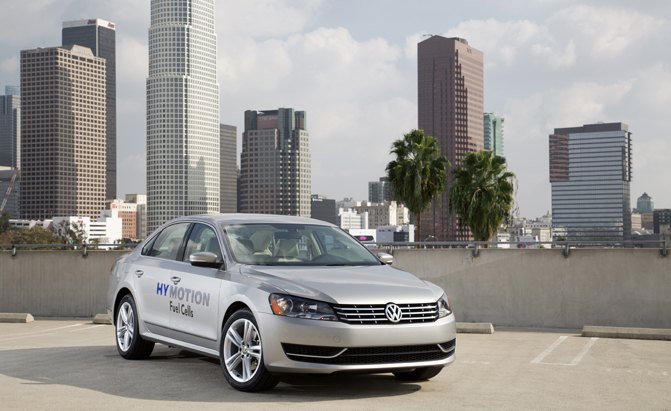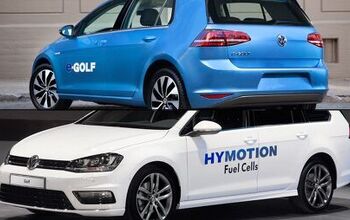Five-Point Inspection: Volkswagen Passat HyMotion Research Vehicle

California is the U.S. hotbed for green cars. Yes, the Golden state has a gargantuan soft spot for alternative fuel, even if it means being a habitually early adopter.
That’s why Volkswagen picked the L.A. Auto Show to the reveal the Volkswagen Golf SportWagen HyMotion, a hydrogen-powered version of its wagonized Golf.
See Also: VW Golf HyMotion Previews Hydrogen Future
I didn’t get a chance to drive it off the show floor, but VW brought the next best thing: a hydrogen-powered Passat that I could take for a spin. Click the arrows below to learn about what it is like to drive.
It might come as a surprise, but the Passat HyMotion borrows several its components from cars VW already sells. For example, the 134-hp electric motor powering the front wheels is the same unit that the new e-Golf uses. It also sports the same 1.1 kWh lithium-ion battery pack as the Jetta Hybrid. This battery stores extra energy from regenerative braking and offers a small temporary power boost.
But this being a hydrogen powered car, it features some unique hardware too. There are four hydrogen tanks stored beneath the rear passenger seats and just above the rear axle. There’s also the hydrogen fuel cell stack that mixes oxygen with the hydrogen to cause a chemical reaction that generates electricity to power the electric motor.
Those four-tanks of hydrogen along with that 134-hp electric motor means that the Passat HyMotion research vehicle has a cruising range of 310 miles. That’s better than the other hydrogen powered cars available in the US. Consider the competition: the newly announced Toyota Mirai can travel 300 miles before hitting empty, while the Hyundai Tucson FCEV can travel a total 265 miles. This Passat is literally miles ahead of them!
But when it comes to speed the Passat HyMotion falls short. It takes 10 seconds to hit highway speeds, which is a bit on the slow side for a mid-size sedan. While it’s slow on the road, this hydrogen car is quick to get going again. A refill of the hydrogen tanks can be done at a station much like a gas powered car where it takes about five minutes to top off.
Since you know it that it’s so very different than any other Passat on the road, it’s easy to be hypersensitive to all the nuances and quirks of this hydrogen powered car, but the truth is that it feels very normal to drive. It combines the usual smooth road-manners of the currently available VW mid-sized sedan with the quiet and torque-heavy thrust of an electric car.
But compared to the least powerful engine in the gas powered Passat (the 1.8-liter turbo that makes 170-hp) the electric motor is less powerful and overall an enthusiastic vehicle to drive. I’d call it acceptable for driving around town, but am not confident in its highway ability.
Volkswagen gets the steering and braking in the Passat HyMotion right. It feels nicely balanced in corners and the regenerative braking isn’t aggressive enough create an unpleasant rocking motion once you take your foot off the gas pedal.
The Passat HyMotion’s biggest advantage is in how easily it can blend in. Granted the car I drove had big “HyMotion” graphics on the doors, but there is little about the car to suggest that it isn’t a run-of-the-mill VW mid-size sedan without the stickers. In other words, Volkswagen is taking its usually conservative approach rather than designing a product that is as memorable for its unusual looks as its powertrain. For example, you might assume any vehicle shaped like a Prius is a hybrid.
The interior is similarly unremarkable, which I prefer over the Toyota Mirai’s particularly complicated interior design. It just feels like another Passat with one exception: the hydrogen tanks impede trunk space, albeit not drastically.
To recap, VW showcased a hydrogen-powered Golf during the 2014 L.A. Auto Show and let the media drive one of the hydrogen powered Passat test mules. If I didn’t know better, it would be tempting to assume Volkswagen showrooms are gearing up to sell them in the near future. But I do know better…
Volkswagen said it isn’t prepared to market hydrogen-powered vehicles until a more robust infrastructure is in place. There are currently only a handful of hydrogen fuelling stations in the U.S., primarily concentrated in California.
See Also: Five Things You Need To Know About the 2016 Toyota Mirai
There is also a lack of detail about when Volkswagen will change its position on the subject. Toyota is launching its hydrogen fuel cell car early next year and planning to finance more hydrogen stations to support its customers. Hyundai also sells a hydrogen-powered version of the Tucson crossover and Honda is preparing a follow up to the FCX Clarity that Honda began building in 2008.

Sami has an unquenchable thirst for car knowledge and has been at AutoGuide for the past six years. He has a degree in journalism and media studies from the University of Guelph-Humber in Toronto and has won multiple journalism awards from the Automotive Journalist Association of Canada. Sami is also on the jury for the World Car Awards.
More by Sami Haj-Assaad





































Comments
Join the conversation